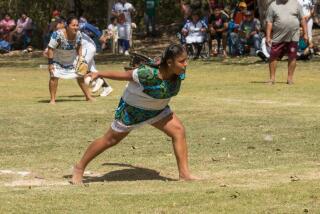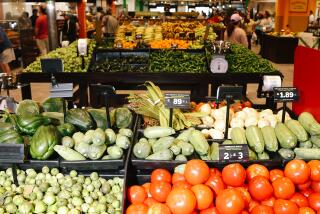Cuzco, Peru’s often overlooked treasures
- Share via
Reporting from Cuzco, Peru — — As many a Peruvian traveler can tell you, climbing Machu Picchu is easy, especially if you take one of those tourist buses that do most of the work. It’s embracing Cuzco that can be hard.
Cuzco (often spelled Cusco) usually is the Peruvian city you fly into before catching the train through the Sacred Valley to those famous mountaintop ruins at Machu Picchu. But Cuzco is much more than a gateway.
In the 15th century, it was the capital of the Incan empire, a wealthy city whose stone buildings, which still form the skeleton of the city, were chiseled and placed with astounding precision. Then in 1533, with the Incas weakened by civil war, Spanish soldiers showed up with rifles and horses to grab the gold and silver and slay those who resisted. They built a colonial capital atop the Incan city, constructing Catholic churches over the most revered Incan temples. Spain ruled until Peru won independence in the 1820s.
Nowadays, the city’s population is 300,000 to 400,000, a blend of Spanish and native Quechua bloodlines, and Cuzco’s stone skeleton is enveloped in one of the most muscular tourist economies in all of South America. Catering to jet-setters and backpackers alike, the city hums with swishy restaurants, cheap hostels, upscale boutiques, tacky souvenir shops and hundreds of posh hotel rooms, yet you still see campesinos bearing sheaves of barley or peddling embroidery on street corners. When the Southern Hemisphere’s winter solstice arrives each June, revelers take to the streets for the Inti Raymi festival, a scene that looks like Mardi Gras with llamas.
Cuzco is not for the faint of heart or lungs, nor for the traveler who wants everything easy, tidy and genteel. Not only does it stand between you and that beloved Incan mountaintop, but it also stands about 11,000 feet above sea level — about 3,000 feet taller than Machu Picchu — because of the tilt of the Sacred Valley.
“That causes a very interesting situation in your body,” guide Enrique Medina reminded me soon after my arrival in May. “Take it easy, have a coca tea and drink a lot of water.”
And while you’re at it, tune out the fast-talking touts and peddlers who will otherwise mar your views of native Cuzco, colonial Cuzco and even crossroads Cuzco.
This was my third visit to Cuzco in 24 years. I came home with these lessons in mind.
The streets and the museums deserve equal time.
History is so alive in the city’s streets, among the throngs at the San Pedro Market and at the sprawling Sacsayhuaman ruins, it might seem a shame to spend too many hours indoors. But especially when Cuzco gets cold, you can’t ignore Qorikancha (also spelled Coricancha), the former Incan headquarters that was later converted into the Convento de Santo Domingo de Cuzco or the Monastery of Santa Catalina, whose 13 remaining nuns may be outnumbered by the mannequins on display.
The same goes for the elegant Museo de Arte Precolumbino, or MAP, and the larger but humbler Inka Museum. Also, authorities last year announced plans to display hundreds of Machu Picchu artifacts, collected by explorer Hiram Bingham, in the Casa Concha mansion on Santa Catalina Ancha Street, but the timetable remains unclear.
Eat your potatoes.
Nobody knows more than the chefs of Cuzco about potatoes, corn, alpaca or cui (a.k.a. cuy, a.k.a. guinea pig). On the courtyard of the Pacha Papa restaurant, you listen to a harpist while digging into an alpaca brochette.
At the MAP Café, the kitchen mixes traditional and molecular cuisine, which in my case resulted in too-sweet gazpacho followed by a tasty salmon main course. At Chicha, a pricey, busy upstairs restaurant opened in 2009 by Peruvian celebrity chef Gaston Acurio, great pork medallions await.
See Barrio San Blas, and think about sleeping there.
Stand in the Plaza de Armas. Turn toward the nearest hill and march past the cathedral and up the narrow, cobblestoned street. For a hearty breakfast or lunch in the company of backpackers from around the planet, pause at Jack’s Café on Choquechaka Street.
Then continue, and in no time you’ll be in San Blas, a hillside barrio that spills down to the plaza and where global visitors mingle with Cuzco’s artistic types. Grab a snack at the tiny, orange-walled Café de Mama Oli (199 Plazoleta Nazarenas), and peek at the lobby of the Hotel Monasterio, where rates routinely run $400 and up a night. This old monastery, built in the 1590s, was converted 47 years ago into a lodging with two courtyards and museum-worthy art. (If you go in March, stay three nights and pay upfront, you can get rooms here for as little as $235.) Then have a look at the Amaru Hostal, a block away, with pleasant, modest rooms for about $50 a night. (I wish I’d slept there instead of at the Andina Classic Cuzco Plaza, where I paid about $140 for a tiny room.)
Beware the plaza, behold the cathedral.
In pictures, the Plaza de Armas looks great — a big sun-splashed rectangle with fountains and grass and strolling vendors and benches for weary travelers. Up close, it’s just as pretty, but it can be a sort of battlefield. To cross it, you’ll need to fend off the school-aged girls selling woven goods and massages, school-aged boys shining shoes and forcefully hawking little paintings that will never hang in the Hotel Monasterio. If you don’t want to buy, avoid eye contact and get into that big, brooding building with the green doors, the cathedral.
Begun in the 1550s and completed in the 1660s, it includes a 25-foot-high “Last Supper” painting by Marcos Zapata behind the main altar. Look closely and you’ll see Christ and his disciples sitting before plates of roasted vizcacha (comparable to chinchilla). You’ll also see a chapel dedicated to Our Lord of the Earthquakes, not a surprise, given that major quakes struck the city in 1650 and 1950.
Mind your paperwork.
Counterfeiting of Peruvian nuevo sol notes and the American dollar is such a big worry in Peru that merchants will eye your paper money the way pawn brokers squint at unconvincing diamonds. The tiniest rip will kill a transaction, and you’ll end up stuck with a bill that you can’t use.
The other paper issue is bathroom-specific. The Peruvian custom is to put used toilet paper in wastebaskets and not to flush it. If you flush it, you could cause a plumbing crisis.
Give the Sacred Valley more time.
There is about 70 miles of valley between Cuzco and Machu Picchu, and it’s not enough to make quick, crowded stops at the ruins and town of Ollantaytambo and the Sunday market at Pisac. Head up to the underappreciated ruins at Pisac. Better yet, head for the salt mines of Maras.
The best thing about Maras might be getting there: You’ll probably take a taxi, guide’s car or minibus, and soon you’ll be rambling up unpaved roads into the middle of a green Peruvian dream of barley and potato fields, ox-drawn plows, wandering sheep and Quechua farmers. Especially for those who aren’t doing a multiday trek, this is a great taste of the countryside.
When you do finally reach the salt mines, you’ll see hundreds of evaporation ponds carved in the red dirt and filled with saline water from a nearby spring. As the water evaporates, salt is harvested every month or so. The revenue has sustained local families for centuries.
Many guides like to combine Maras with the nearby Moray archaeological site, a series of terraced, concentric circles that were apparently used as a pre-Columbian agricultural laboratory. The valley is full of options, including the rustic town of Chinchero; the luxurious Sol & Luna Spa & Lodge (www.hotelsolyluna.com) in Urubamba; the bungee jumps and paragliding of Action Valley (www.actionvalley.com); and the challenges of the Natura Vive via ferrata (www.naturavive.com), a dramatic climbing route with cables to ease your ascent.
All these places are within about 40 miles of Cuzco. If you buy a Boleto Turistico del Cusco (about $50), it will cover the cost of admission to Moray, Pisac, Ollantaytambo, Sacsayhuaman and several other ruins and museum sites. If you have more time than money, you can cut costs by waiting to book day trips until you arrive in Cuzco. Once here, gather fresh references from other travelers and question a few outfitters. They’ll be easy to find, especially in the storefronts surrounding the Plaza de Armas.
More to Read
Sign up for The Wild
We’ll help you find the best places to hike, bike and run, as well as the perfect silent spots for meditation and yoga.
You may occasionally receive promotional content from the Los Angeles Times.







